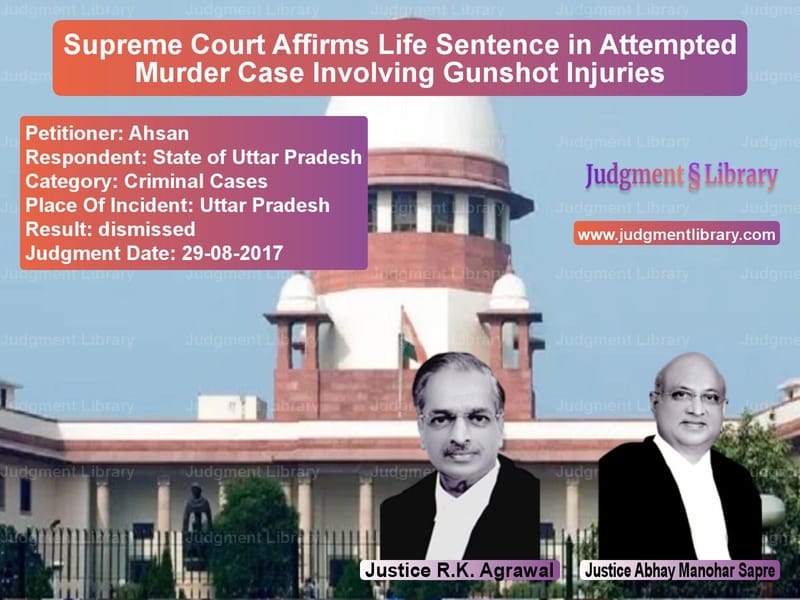Supreme Court Affirms Life Sentence in Attempted Murder Case Involving Gunshot Injuries
The case of Ahsan v. State of Uttar Pradesh revolved around an appeal filed by the appellant against the conviction and sentence imposed by the High Court. The appellant was convicted for multiple offenses, including attempt to murder under Section 307 of the Indian Penal Code (IPC), after being found guilty of shooting three individuals in an attempt to kill them. The Supreme Court had to decide whether the sentence imposed was appropriate based on the severity of the crime.
Background of the Case
The appellant, Ahsan, was involved in an altercation on October 8, 2004, when he, along with two other accused individuals, armed with country-made pistols, attacked members of a family in their house in Shamli, Muzaffar Nagar. During the attack, they fired shots at the victims with the intention of killing them. The bullet fired by Ahsan struck Shahzad in the head, leading to serious injuries. Another bullet fired by another accused, Kamil, caused injuries to Rukhsana, who was pregnant at the time, resulting in a miscarriage.
Following the incident, an FIR was filed, and the case went to trial. The Additional Sessions Judge found Ahsan guilty under Sections 452, 307/34, 316/34, and 504 of the IPC, sentencing him to life imprisonment along with fines and additional jail terms. The appellant appealed to the Allahabad High Court, which upheld the conviction and sentence. The appellant then approached the Supreme Court for further relief.
Key Legal Issues
- Whether the life sentence under Section 307 was justified, considering the survival of the victim who was shot in the head.
- Whether the Courts erred in sentencing the appellant to life imprisonment or whether a lesser sentence could be considered.
- Whether the facts of the case warranted any reduction in the sentence considering the appellant’s prior jail time.
Arguments by the Parties
Petitioner’s Arguments (Ahsan)
The petitioner contended that:
- The fact that Shahzad survived the gunshot should have been taken into account when determining the sentence. It was argued that the offense should have been classified under the first part of Section 307 IPC, which prescribes a maximum sentence of ten years rather than life imprisonment.
- The appellant had already served 10-12 years in custody, which should be considered when determining the fairness of the sentence.
- While the appellant was convicted for grievous offenses, the circumstances surrounding the shooting, including the survival of the victim, suggested that the sentence should be reduced.
Respondent’s Arguments (State of Uttar Pradesh)
The respondents argued that:
- The offense committed was grave and fell within the second part of Section 307 IPC, which provides for life imprisonment or a term extending to ten years along with a fine.
- The injuries caused to Shahzad, who was shot in the head, were severe, and the appellant’s actions indicated a clear intention to cause death.
- Even if the victim survived, the nature of the injury and the appellant’s criminal intent warranted the life sentence.
Supreme Court’s Judgment
The Supreme Court, comprising Justices R.K. Agrawal and Abhay Manohar Sapre, dismissed the appeal, upholding the life sentence imposed by the lower courts.
“The two Courts below did not commit any error in exercising their judicial discretion in awarding life imprisonment. The nature of the offense, the manner in which it was committed, the gravity of the injuries, and the intent behind the act support the sentence awarded.”
The Court held that:
- The fact that Shahzad survived the gunshot did not reduce the severity of the offense. The gunshot injury was grievous and caused to a vital part of the body.
- The appellant’s actions, including the use of a firearm to commit the crime, indicated a clear intent to cause death, making life imprisonment the appropriate punishment.
- The appellant’s reliance on the case of Sanjay v. State of Uttar Pradesh was found to be distinguishable, as it involved different facts where the conviction was altered from Section 302 to Section 304 Part I.
Key Legal Observations
- The Court emphasized that when determining the severity of the punishment, several factors must be considered, including the nature of the offense, the manner in which it was committed, and the injuries sustained by the victim.
- For offenses under Section 307 IPC, even if the victim survives, the intention behind the crime plays a significant role in determining the sentence.
- The discretion of the trial court and appellate court in awarding sentences is rarely interfered with unless there are compelling reasons.
Final Order
The Supreme Court dismissed the appeal, affirming the life sentence awarded to the appellant. The Court found no merit in the appellant’s argument that a lesser sentence should be imposed.
Conclusion
This ruling underscores the seriousness of attempted murder cases, particularly those involving firearms, and reinforces the principle that the severity of the offense and the intent of the accused are key factors in determining the punishment. The Court’s decision in this case highlights the importance of considering both the nature of the crime and the circumstances surrounding it when passing sentence.
Don’t miss out on the full details! Download the complete judgment in PDF format below and gain valuable insights instantly!
Download Judgment: Ahsan vs State of Uttar Prade Supreme Court of India Judgment Dated 29-08-2017.pdf
Direct Downlaod Judgment: Direct downlaod this Judgment
See all petitions in Murder Cases
See all petitions in Attempt to Murder Cases
See all petitions in Fraud and Forgery
See all petitions in Judgment by R K Agrawal
See all petitions in Judgment by Abhay Manohar Sapre
See all petitions in dismissed
See all petitions in supreme court of India judgments August 2017
See all petitions in 2017 judgments
See all posts in Criminal Cases Category
See all allowed petitions in Criminal Cases Category
See all Dismissed petitions in Criminal Cases Category
See all partially allowed petitions in Criminal Cases Category







